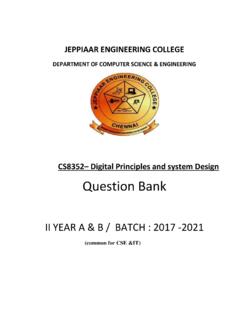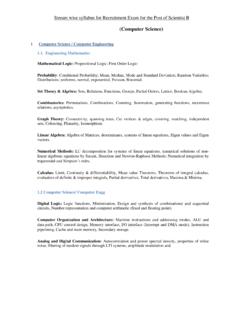Transcription of Xtensa LX6 Customizable DPU
1 Tensilica Datasheet Xtensa LX6 Customizable DPU. High performance with flexible I/Os and wide data fetches Cadence provides system-on-chip (SoC) designers with the world's first and only configurable and extensible processor cores fully supported by automatic hardware and software generation. Cadence Tensilica Xtensa processors, such as the Xtensa LX6 dataplane processing units (DPUs), enable SoC designers to add flexibility and longevity to their designs through software programmability as well as differentiation through processor implementations tailored for the specific application. Features Benefits Highly efficient, small, low-power 32-bit base architecture Develop hardware for complex dataplane processing Configurable over a wide range of pre-verified options significantly faster compared to pure RTL methods including 10 different digital signal processing (DSP)
2 High-bandwidth data flow through processor with flexible choices I/O interfaces that are independent of the system bus Extend with designer-defined, application-specific Quickly and easily scale hardware architecture with instructions, execution units, register files, and I/Os task-customized processors Virtually unlimited I/O bandwidth with multiple, wide, Lower verification effort with pre-verified, correct-by- designer-defined FIFO, GPIO, and lookup interfaces construction RTL generation Selectable 5- or 7-stage pipeline depth for core instruction Post-silicon programmability set architecture (ISA), plus extended DSP pipelines up to 11 Accurate high-speed processor and system simulation stages models automatically created for software development Local memories configurable up to 8MB with option for Simplified multi-core debugging memory parity or ECC. Huge bandwidth, more parallelism to reduce cycle counts Up to 128b-wide flexible-length instruction extensions (FLIX) instructions Low-leakage power design Multi-core on-chip debug (OCD)
3 With break-in/break-out Dynamic power savings Dual-load/stores each up to wide with data cache support Easy integration into an ARM CoreSight interface-based and multi-bank RAM support debug and trace infrastructure Power domains for power shut-off Single-/double-precision scalar floating-point options to match the exact application requirements Semantic and memory data gating Mature, highly optimizing C/C++ compiler means you can Compatible interfaces for ARM CoreSight debug and work at the C' level for most applications trace technology IEEE 754-compliant single-/double-precision scalar floating-point unit Complete matching software development tool chain automatically generated for each core Xtensa LX6 Customizable DPU. Processors for the Challenges of the SoC Optional pre-defined execution units Dataplane 32-bit multiplier and/or 16-bit multiplier and MAC. IEEE 754-compliant single-/double-precision scalar RAM, Cache floating-point unit RTL Double-precision scalar floating-point acceleration RTL.
4 3-way 64-bit FLIX (FLIX3) for interleaved very long instruction Xtensa LX6. DPU. word (VLIW) and regular instructions RTL, Scratchpad, Pre-defined 32-bit GPIO and FIFO-like queue interfaces Peripherals Lookup Memory Optional execution units (additional licensing). System Bus ConnX D2 DSP engine System Blocks ConnX Vectra LX DSP engine Figure 1. Xtensa LX6 DPU: Flexible direct connections ConnX Vectra VMB for baseband acceleration allow RTL-like throughput ConnX BBE16, BBE32-EP, and BBE64-EP baseband engines Inside today's complex systems on chips (SoCs), you can find many HiFi-3, HiFi EP, HiFi-2, and HiFi Mini Audio/Voice DSPs different processors from general-purpose processors to function- specific offload engines that add programmability and flexibility. IVP-EP 32-way SIMD Imaging/Video DSP. Although general-purpose embedded processors can handle Differentiate with designer-defined instructions most of the control tasks well, they lack the bandwidth needed to perform complex, data-processing tasks such as network packet Make your specific algorithm run even more efficiently by processing, video processing, and digital cryptography.
5 Chip adding the instructions it needs designers have long turned to hardwired logic (blocks of RTL) to Development tools automatically adapt for full support implement these key functions. The problem with the RTL blocks is that they take too long to design, take even longer to verify, and Natural connectivity with RTL blocks are not programmable. Multiple custom-width I/O ports for peripheral control and Xtensa LX6 DPUs are configurable and extensible and ideal for monitoring handling complex compute-intensive digital signal processing (DSP) Multiple custom-width queue interfaces to FIFOs for data applications where a register-transfer level (RTL) implementation streaming into and out of the processor may be the only other option. Co-simulation with RTL down to the pin level in SystemC. Configurable Highly configurable interfaces You are offered a menu of pre-verified checkbox and drop-down Optional processor interface (PIF) to system bus, choice of 32-, options ranging from memory size and width to complex DSP 64-, or 128-bit width with in-bound slave DMA option functions.
6 Optional ARM AMBA AXI and AHB-Lite interfaces with Extensible synchronous or asynchronous clocking Write buffer, selectable from 1 to 32 entries You can use the Tensilica Instruction Extension (TIE) methodology, based on the Verilog language, to implement datapath elements in Up to 128b-wide instructions and up to two 512b-wide load/. the processor pipeline and add more I/Os. The control finite state stores and hardware prefetch unit machine (FSM) for datapath elements is implemented as software Optional second data load/store unit with data cache support running on the processor. Just specify the functional behavior of Choice of 1-, 2-, or 4-way cache and local memories the datapath and the RTL is automatically generated, along with the full matching software tool chain and models. Up to 32 interrupts Multi-core design style support Feature Overview Multi-core system creation, modeling , and SystemC.
7 Modern ISA with true multi-generational compatibility co-simulation out-of-the-box, fully supported within the Xtensa Xtensa ISA fundamentally architected for extensibility Xplorer integrated design environment (IDE). Base instruction set of 80 RISC instructions for compatibility Homogenous and heterogeneous subsystems supported across every Xtensa core Inter-core OCD with break-in/out control Dozens of available optional blocks Optional 16-bit processor ID, supporting massively parallel array Any differentiating designer-defined instructions written since architectures 1998 can still be re-used today Conditional store instruction option and synchronization library provide shared memory semaphore operations and the release consistency model of memory access ordering 2. Xtensa LX6 Customizable DPU. Complete hardware implementation and verification Dynamic and leakage power improvements flow support Power shut off (PSO) feature allows Xtensa DPUs to be Automatic generation of RTL and tailored EDA scripts for completely powered off.
8 To help achieve low leakage, Xtensa leading-edge process technologies, including physical synthesis DPUs can now be divided into multiple power domains and and 3D extraction tools each power domain operates at the same voltage and can be shut down and powered up individually Auto-insertion of fine-grained clock gating for low power Dynamic power-saving features including semantic and data Hardware emulation support including automated FPGA netlist power gating generation for rapid SoC prototyping Software cache way usage control allows a programmer to Comprehensive diagnostic test bench to verify connectivity adjust cache dynamic power on the fly Formal verification support for designer-defined instructions Robust real-time operating system support High-speed, high-accuracy system simulation models Use Mentor Graphics Nucleus+, Express Logic's ThreadX, automatically created Micrium's uC/OS-II, or the embedded Linux operating systems High-speed instruction-accurate simulator for software development Efficient Base Architecture Pipeline- modeling , cycle-accurate Xtensa instruction set The Xtensa LX6 32-bit architecture features a compact instruction simulator (ISS).
9 Set optimized for embedded designs. The base architecture has a Xtensa SystemC (XTSC) transaction-level modeling support, 32-bit ALU, up to 64 general-purpose physical registers , 6 special- including out-of-the-box multi-core simulation purpose registers , and 80 base instructions, including 16- and Hardware co-simulation with RTL in SystemC with 24-bit (rather than 32-bit) RISC instruction encoding. Key features pin-level XTSC include: A wide range of configurable options to ensure you get just IDE. the logic you need to meet your functional and performance Create, simulate, debug, and profile whole designs in one tool, requirements the high-productivity Xtensa Xplorer IDE. Modelessly intermixed standard 16- and 24-bit instructions, as Tenth-generation software development tools target each well as designer-defined FLIX instructions of any size from 4 to processor. The advanced Xtensa C/C++ compiler includes 16 bytes, resulting in highly efficient code that is optimal for optimizations for base, optional, and designer-defined both memory size and performance instructions Selectable 5-or-7-stage core ISA pipeline to accommodate Vectorization Assistant directs the programmer to areas of the different memory speeds, plus extended DSP execution application that can benefit most from modifications to enable pipelines up to 11 stages, and designer-defined instruction better vectorization pipeline depths up to 23 stages Multi-core subsystem design and simulation support Virtually unlimited I/O bandwidth with optional queue (FIFO), Custom data display formatting for easy debug of vector and port (GPIO)
10 , and lookup interfaces for data transfers that are fixed-point data types as well as bit-mapped status and control not dependent on the limited system bus bandwidth Automatic Xtensa Overlay Manager (AXOM) provides run-time One or two 32-/64-/128-/256-/512-bit-wide load/store units management of large programs in small memories Local memories configurable up to 8MB with optional parity or ECC. Multi-core debug and ease of use Optional hardware prefetch reduces memory latencies Interfaces to support CoreSight infrastructure Automated fine-grained clock gating throughout processor for OCD hardware widely supported by third-party JTAG. ultra-low power solutions debug probes Can be multi-issue VLIW architecture for parallel instruction DebugStall feature allows Xtensa processors to be stopped and execution with FLIX. started together using a hardware signal and to be debugged while in the stalled state Base ISA compatibility Optional performance counters for real-time system analysis Configurability of an Xtensa processor core builds on the XMON software debug monitor for real-time applications underlying base Xtensa ISA, thereby ensuring availability of Multi-core OCD support a robust ecosystem of third-party application software and development tools.





